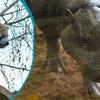The Royal Zoological Society of Scotland (RZSS) has participated in the first ever release of threatened dark bordered beauty moth eggs. 750 eggs were released into a specially selected site in the Cairngorms National Park as part of the Rare Invertebrates in the Cairngorms (RIC) partnership work.
Dr Helen Taylor, conservation programme manager at RZSS, said, “This is definitely a first for us. Last year, we released dark bordered beauty moth caterpillars into the wild and saw some success. This year, we have over 3,500 eggs in our breeding facility at Highland Wildlife Park. This is fantastic news, but looking after caterpillars is very involved and we cannot raise them in the thousands. This is an animal that spends 10 months of its 12-month life cycle hidden away as an egg and we’re really excited to see what kind of success we have with this release approach. We’ll be repeating the process with another 750 eggs right before they start hatching in May.
“Working to reverse species decline is crucial as we face a global biodiversity crisis. Invertebrates, like dark bordered beauty moths, play important roles in ecosystems. Thanks to our partners and support from funders and other conservation champions, we can make a difference for these often-overlooked species.”
Following the egg releases, the team will also be releasing caterpillars and adults later in the year. Meanwhile, some individuals will remain in the breeding programme in an attempt to produce as many eggs as possible to enable future releases to other sites.
Suitable habitat sites for the species are fragmented with large distances between them, meaning these moths are not currently able to disperse to new sites themselves. As part of habitat management efforts, RIC partners have been undertaking surveys to find new sites of suckering aspen and working with landowners to try and help create better habitat for the moths to be released into.
During the releases the wildlife conservation charity’s team found an egg which may have been from the individuals that were released last year.
Dr Taylor continued “If this is a dark bordered beauty egg, it would mean some of the caterpillars released last year survived into adulthood and bred. We can’t be certain in this case as some other moth species have similar eggs, so together with partners we will continue to monitor the sites and hopefully in future we will see evidence of the released dark bordered beauty moths producing new generations in the wild.”
Tom Prescott, Head of Conservation, Butterfly Conservation Scotland said, “This is an egg-citing step forward in the recovery of one of the UK’s rarest moths, with the release of the eggs appropriately in the run up to Easter. The moth is currently confined to just three isolated and small populations in Scotland and one in England so it is essential we try and establish it at a new site.”
This work is possible thanks to the Cairngorms National Park Authority, Cheeky Panda, and players of People’s Postcode Lottery. It is supported by the Scottish Government’s Nature Restoration Fund, managed by NatureScot.
The dark bordered beauty moth conservation breeding for release project runs in collaboration with the Rare Invertebrates in the Cairngorms project, a partnership between Butterfly Conservation Scotland, RSPB Scotland, Cairngorms National Park Authority, RZSS, Buglife Scotland and NatureScot.
Related Members
-
News
 Belfast Zoo helps to bring Christmas joy to Children’s Hospital 19th December, 2025Belfast Zoo joined the Lord Mayor of Belfast, Councillor Tracy Kelly, on Monday (15th December) to help bring festive cheer to the Royal Belfast Hospital…
Belfast Zoo helps to bring Christmas joy to Children’s Hospital 19th December, 2025Belfast Zoo joined the Lord Mayor of Belfast, Councillor Tracy Kelly, on Monday (15th December) to help bring festive cheer to the Royal Belfast Hospital… -
News
 Colchester Zoological Society welcomes new arrivals 19th December, 2025This December, Colchester Zoological Society (CZS) welcomed some exciting new arrivals! A young male pygmy hippo, Mikolas, from Zoo Dvur Kralove…
Colchester Zoological Society welcomes new arrivals 19th December, 2025This December, Colchester Zoological Society (CZS) welcomed some exciting new arrivals! A young male pygmy hippo, Mikolas, from Zoo Dvur Kralove… -
News
.png?w=100&h=100&zc=1&f=jpeg&hash=8d175f93cde920c5ba23c8ea7f92e55a) Blog: Understanding the human side of zoos 16th December, 2025Why are zoo researchers increasingly looking to social science? Dr Nieky van Veggel explains the significance of understanding the human dimension…
Blog: Understanding the human side of zoos 16th December, 2025Why are zoo researchers increasingly looking to social science? Dr Nieky van Veggel explains the significance of understanding the human dimension…

.png?w=100&h=50&zc=1&f=jpeg&hash=fbbed9e60e5c48d1053e672edc0a2622)

